
Features
Growing Media
Inputs
Special Series in the rootzone #8: Regular nutrient analysis
March 21, 2012 By Andrew Lee
As a grower, one of the most important responsibilities is to establish and maintain a balanced nutrient solution and keep an optimum level of each nutrient element available in the rootzone environment throughout the entire production season. Plants require 16 elements for normal growth: carbon (C), hydrogen (H), oxygen (O), nitrogen (N), phosphorus (P), potassium (K), calcium (Ca), magnesium (Mg), sulphur (S), iron (Fe), manganese (Mn), boron (B), zinc (Zn), copper (Cu), molybdenum (Mo) and chlorine (Cl).
 |
|
| Grodan’s program offers growers an opportunity to draw up crop nutrition recipes. Advertisement
|
Carbon, hydrogen and oxygen are supplied from air and water. The other 13 elements are supplied in the hydroponic feed solution. Understanding how the plant uses each element and its role in plant development is the first step towards achieving a balanced nutrition program.
Nitrogen (N) is a very important element for plant growth and is found in many compounds. These compounds include chlorophyll, amino acids, proteins, nucleic acids and organic acids. Nitrogen is the main nutrient responsible for the development of leaf area.
Phosphorus (P) is responsible for cell division and energy transfer reactions during photosynthesis. It is a component of certain enzymes and proteins.
Potassium (K): the role of potassium is related to the quality and quantity of fruits and in this respect is responsible for the synthesis of lycopene during the ripening process of tomatoes. The K+ ion promotes photosynthesis and production of proteins and intensifies the transport of sugars from the leaf to the fruit. Potassium is also involved in the maintenance of the plants’ osmotic potential and regulates the opening and closing of the stomata. Potassium also improves the efficiency of nitrogen fertilizers and water use by the plant.
Calcium (Ca) is used in the development of new cell walls and, once incorporated into the cell, it is immobile within the plant. Without calcium, new tissue development of roots and shoots is prevented. Calcium is the only element transported in the xylem (water flow) and therefore, due to transpiration, is accumulated mainly in the leaves. Only five per cent of calcium goes to the fruit, so the supply and demand relationship of fruits for calcium will determine the crops’ susceptibility for blossom end rot.
Magnesium (Mg) is the central element of the chlorophyll molecule. Without it, photosynthesis would not occur.
Sulphur (S) plays the main role in synthesis of amino acids.
Chlorine (Cl) is involved in the evolution of oxygen during the photosynthetic process and is essential for cell division in roots and leaves.
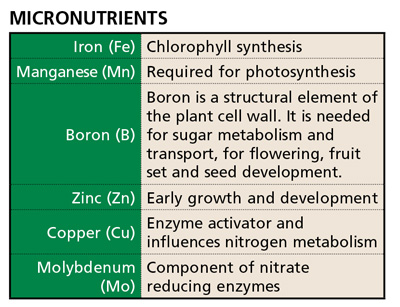 |
PLANT GROWTH
■ Because each essential element has a different role within the different plant processes, the uptake of nutrients will be selective and will vary depending on plant growth, development and balance.
 |
|
| Regular nutrient analysis will produce high yields and good quality fruit.
|
For example, there is an increase in potassium uptake during flowering of the first 10 clusters in tomato crops with maximum uptake at the flowering of the seventh to 10th cluster. In the same period, the uptake of calcium and magnesium is decreased. To ensure plants have an adequate and balanced supply of each essential element in the substrate, the nutrient composition in the drip should be adjusted on a regular basis. This can only be achieved by regular, i.e., weekly, analysis of the slab solution (Table 1.0). Note, the drain solution can be used when recycling drain water but only with drain volumes >20 per cent.
Table 1.0 illustrates the results of a slab analysis. This should be compared with the target values in the rootzone environment shown in Tables 2.0 and 3.0.
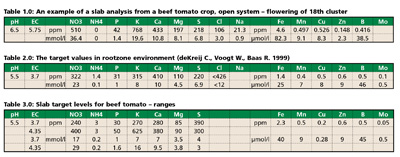 |
HOW TO ACHIEVE BALANCE
Of course, the simplest way is to send the nutrient solution to a reputable laboratory for analysis and recommendation. Alternatively, if you have the analysis, you can also use the Grodan Crop Nutrition program to make the calculation and adjustments for you. This is an online and interactive calculation program that offers growers an opportunity to draw up nutrition recipes.
Whatever method is used, the example illustrated in Table 1.0 highlights the process involved. Firstly, the report’s EC is reduced by value which is given by Na, i.e., 5.75 mS/cm-(0.9 mmol / l x 0.05) = 5.70 mS/cm.
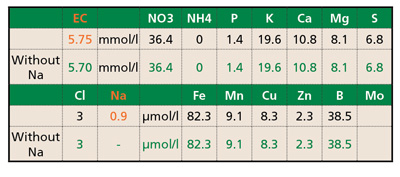 |
The figures of macronutrients (without N-NH4) are now corrected by an EC factor, i.e., EC target / EC report-reduced 3.7 / 5.7 = 0.65
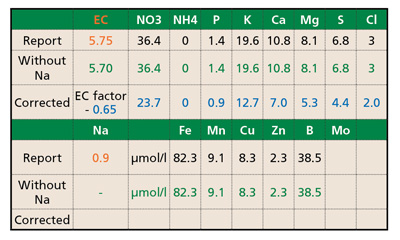 |
Now, the value from analysis can be compared with the target values listed in Table 2.0 and provide an indication as to the level (too high “H” or too low “L”) of each element.
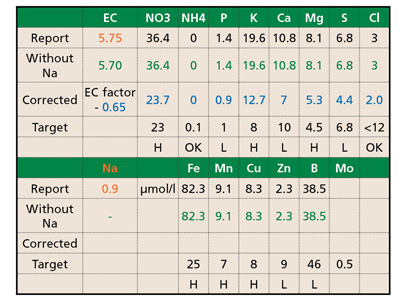 |
In this example, the levels of macronutrients such as N-NO3, K and Mg are too high in the slab, as are the concentrations of micronutrients with the exception of boron (B) and zinc (Zn).
The feed solution, therefore, requires adjustment. The range of the nutrient solution correction is different for individual macro elements: +/- 0.5 mMol/l for P, Mg and S; +1.5, +0.75, -0.75, -1.5 for Ca; and +3.0 +1.5 -1.5, -3.0 for N-NO3 and K. The micronutrients are increased or decreased by 25-50 per cent.
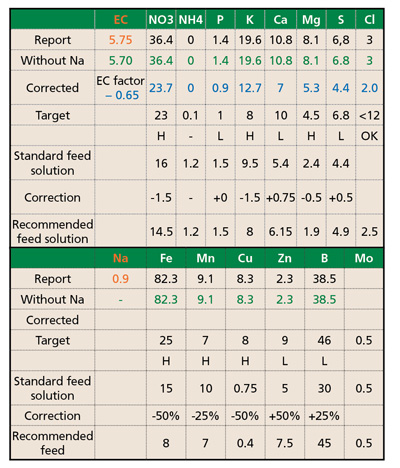 |
Of course, the total EC in the slab should also be controlled and stabilized by a structured irrigation strategy, i.e., matching irrigation to light under the general principle 3.0 ml/joule and maybe incorporating a light decrease in the EC setting.
SUMMARY
■ Knowledge of the role of macro- and micro-elements in the plant’s metabolism is the basis for providing a targeted and precise nutrient feed program. The responsibility of growers is to keep an optimum level of each nutrient element available in the rootzone environment throughout the entire production season. Regular analysis of slab solution and the correct interpretation of the results provide the opportunity to prepare an appropriate feed solution.
This is the one way to guarantee plants of the highest quality and, consequently, high yields of good quality fruit.
Print this page